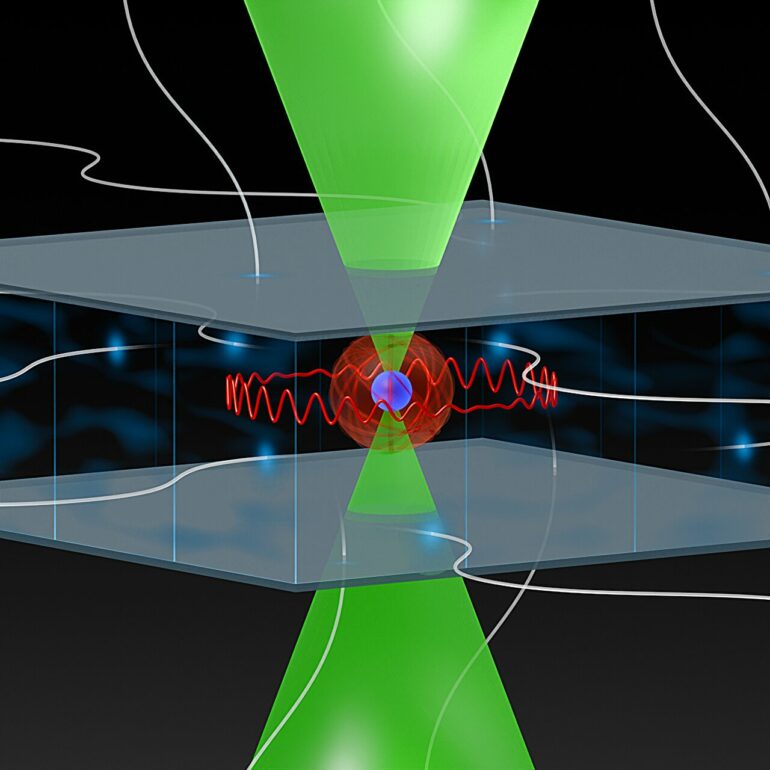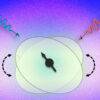A team of researchers from the 5th Institute of Physics at the University of Stuttgart is making important progress in the field of quantum simulation and quantum computing based on Rydberg atoms by overcoming a fundamental limitation: the limited lifetime of Rydberg atoms. Circular Rydberg states are showing enormous potential for overcoming this limitation.
The paper is published in the journal Physical Review X.
In the world of quantum computing and quantum simulation technology, there is a fundamental challenge when using neutral atoms: The lifetime of Rydberg atoms, which are the building blocks for quantum computing, is limited. But there is a promising solution: circular Rydberg states.
For the first time, the research team has succeeded in generating and capturing circular Rydberg atoms of an alkaline-earth metal in an array of optical tweezers.
“This is exciting because they are particularly stable and can extend the lifetime of a quantum bit enormously. They therefore have great potential for the development of more powerful quantum simulators,” says Dr. Florian Meinert, Head of the Junior Research Group at the 5th Institute of Physics, who is in charge of the project.
The significance of circular Rydberg atoms
A circular Rydberg atom is a particular type of Rydberg atom in which the excited electron follows a circular path around the atomic nucleus. Compared to other Rydberg states, these atoms have an increased stability and a longer lifetime. This makes them attractive candidates for use as qubits.
Circular Rydberg states have been known for decades and were the key to Nobel Prize-winning experiments on the quantum nature of light-matter interaction. Recently, the potential of these states for quantum computing has been increasingly discussed again.
Strontium, an alkaline-earth metal
Strontium, an alkaline-earth metal with two optically active electrons, was chosen to create the Rydberg atom since it offers unique possibilities. Once prepared in the circular Rydberg state, the second electron orbiting the atomic nucleus can be used for quantum operations that are already known from research on ion quantum computers.
The research team demonstrated the generation of very high-energy circular states of a strontium isotope with an astonishingly long lifetime of up to 2.55 milliseconds at room temperature. They made use of the special properties of a cavity that suppresses the interfering blackbody background radiation, which would drive the sensitive Rydberg electron into other energetically neighboring Rydberg levels.
Without this shielding, the circular states would not be able to survive for long. “They also owe their longer lifetime to their maximum angular momentum, which protects them from decay. This means that the quantum bits are more stable and therefore less susceptible to errors and external interference,” explains Christian Hölzl, Ph.D. student at the 5th Institute of Physics.
Quantum bits under control
Another important aspect of the research was the precise control and manipulation of a microwave quantum bit encoded in circular states. This so-called coherent control enabled the scientists to use microwave pulses to switch the qubit between different states without losing its quantum information.
They were able to precisely determine the lifetime of the quantum bit and gain important insights into its stability at room temperature. Effective coherent control is crucial for performing quantum operations and makes them precise and reliable.
A wide range of applications
Circular Rydberg atoms offer a multitude of possibilities for performing quantum operations and, in particular, quantum simulations. “Their versatility makes them attractive for a wide range of applications,” says Prof. Tilman Pfau, Director of the 5th Institute of Physics and the supraregional Carl Zeiss Foundation Center for Quantum Photonics at Jena, Stuttgart and Ulm (CZS Center QPhoton).
Since circular Rydberg atoms can be specifically trapped and precisely manipulated in optical tweezers or other types of traps, they offer possibilities for a scalable architecture that could be advantageous in the future for building large quantum bit systems based on neutral atoms.
More information:
C. Hölzl et al, Long-Lived Circular Rydberg Qubits of Alkaline-Earth Atoms in Optical Tweezers, Physical Review X (2024). DOI: 10.1103/PhysRevX.14.021024
Provided by
University of Stuttgart
Citation:
Physicist achieve milestone in quantum simulation with circular Rydberg qubits (2024, May 8)



